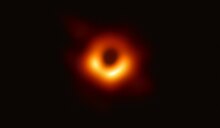In case you've been living under a rock or off the grid, you will have heard the news of the first image of a black hole. It looks like this:
 |
| A direct image of the black hole at the core of galaxy Messier 87. |
A black hole is a final object (greater than ~2M☉) that has collapsed down due to gravity, because there's no other force (like thermal pressure) to counter the gravity.
Theoretically, we've known about black holes since 1915-ish when Einstein had a few theories about gravity, and Karl Schwarzschild talked about the gravitational fields of mass points. Even the idea behind something so massive that even light cannot escape its gravity has been around since the 18th Century.
Are black holes a real thing? Yes. We know them by their gravitational influence, as well as a few other clues. Here's a couple of recent papers that cover a few things about one of the best-studied black holes, Sagittarius A*, in delightfully nerdish details:
- A geometric distance measurement to the Galactic Center black hole with 0.3% uncertainty
- Test of the Einstein Equivalence Principle near the Galactic Center Supermassive Black Hole
So yeah. Black holes, totally real, and we've known and studied them for at least a hundred years. Thing is, due to their nature, we haven't been able to take a picture of one.
It's hard to take a photo-graph of something that doesn't emit or reflect any photons. So, how did they do it?
In their reportings in the Astrophysical Journal, the team shared, "Einstein's general theory of relativity not only predicts the existence of black holes, but also provides a means to directly observe them. Photons can escape from near the event horizon via an unstable circular orbit, whose observational manifestation would be a bright ring of emission surrounding a dark interior black hole "shadow". The diameter of the shadow for a black hole...as seen by a distant observer is predicted to be...larger than twice the...radius of the event horizon due to light-bending effects...."
This method is only successful if: "(i) there are a sufficient number of emitted photons to illuminate the black hole, (ii) the emission comes from close enough to the black hole to be gravitationally lensed around it, and (iii) the surrounding plasma is sufficiently transparent at the observed wavelength."
And it was. I'm impressed.
(I can't believe I've not devoted an entire blog entry to black holes before! Bad astronomer! No cookie!) If you want to see more science content from me on my blog, please comment below. I'm happy to oblige. If not, go buy my books and register your opinion that way.
Dr Katie gave a TED talk a couple of years ago about how one would go about imaging a black hole:
Do watch this video. She's so excited and passionate by the science. It's contagious. I love her line, "I can't show you a picture of a black hole today [in 2017]."
Well, Katie, you can now:
Papers here for those who want to go hardcore:
- First M87 Event Horizon Telescope Results. I. The Shadow of the Supermassive Black Hole
- First M87 Event Horizon Telescope Results. II. Array and Instrumentation
- First M87 Event Horizon Telescope Results. III. Data Processing and Calibration
- First M87 Event Horizon Telescope Results. IV. Imaging the Central Supermassive Black Hole
- First M87 Event Horizon Telescope Results. V. Physical Origin of the Asymmetric Ring
- First M87 Event Horizon Telescope Results. VI. The Shadow and Mass of the Central Black Hole


No comments:
Post a Comment